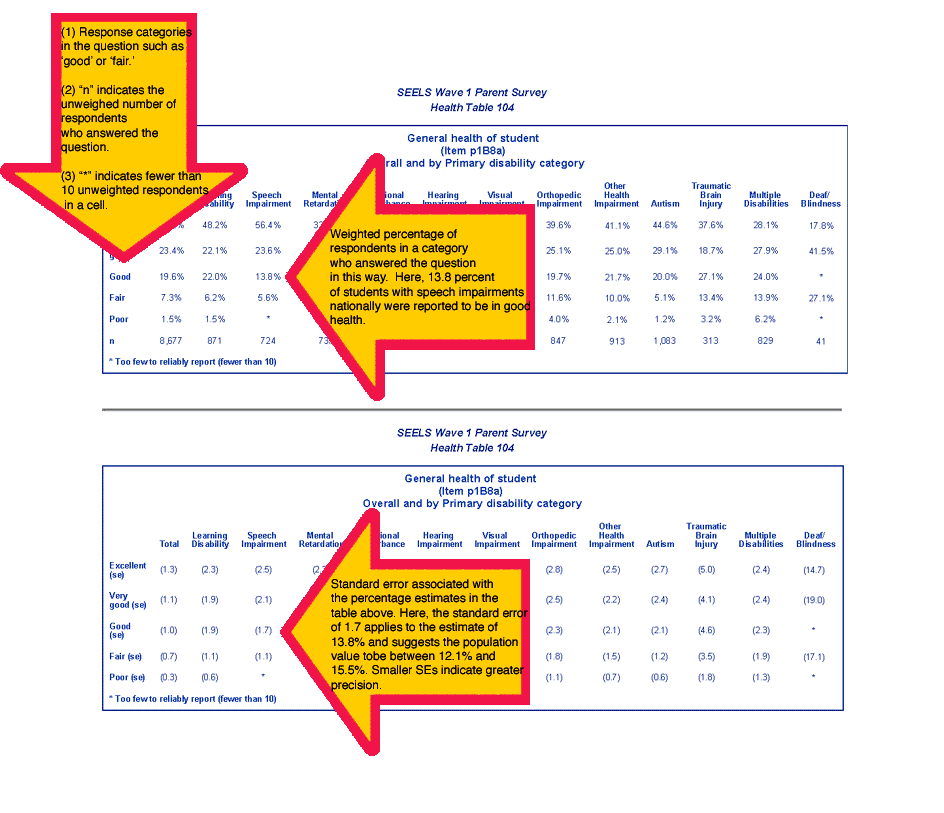Skip Navigational Links
| Data Tables Overview |
Step 1: Choose Data Source |
Step 2: Choose Conceptual Area |
Step 3: Choose Topic |
Step 4: Selection Result |
How to Read SEELS Tables |
SEELS Home & News |
DATA TABLES
How to Read SEELS Tables
You
will go through a three-step process to select the data you would like
to see: (1) Data Source, (2) Conceptual Area, and (3) Topic. You will
then be able to view your selection by selecting the "View Tables"
button. Below we provide information regarding how to use and interpret
the data tables.
-
Your selected data are presented in one single page containing 10
tables (5 data tables and 5 standard error tables). A table of contents
frame at the left allows you to quickly move from table to table.
- The
five (5) data tables present your selected topic cross-tabulated by student
disability category, gender, age group, family income, and ethnicity/racial
group, each in a separate table.
- The
percentages in the data tables are organized by column, so that the
number indicates the weighted estimate of respondents nationally who
responded in that way. In the example below, 13.8 percent of students
with speech impairments were reported to be in 'good health.'
- Following
each data table is a table indicating standard errors associated with
the data in the preceding table. Standard errors are an indication
of the precision of the reported percentage. Small standard errors
allow for greater confidence to be placed in the value. Large standard
errors, on the other hand, require a greater degree of caution in
interpretation.
- The
size of individual standard errors is linked to the unweighted number
of respondents in a specific category of students. In SEELS, there
are several groups of students whose numbers in the unweighted sample
are comparatively small and are often associated with large standard
errors. Among these groups are the following: students classified
by the school as deaf-blind, Native American, or ages 13 and over.
Users should use caution in interpreting results involving these groups.
- Standard
errors can also be higher because certain questions are only asked
of a subset of respondents based on their responses to previous questions.
- Some
questions were asked to comparatively small numbers of respondents (as low as n=100).
Tables displaying these data will show values only if the unweighted subgroup was more than
35. So, it is possible to have valid values for the population, but values for the subgroups
may be blank.
- Use
the following format to cite the source of data coming from this site:
Special Education Elementary Longitudinal Study. (2002). SEELS data
tables. Available at: http://www.seels.net.
- Finally, we hope that you enjoy the tables and find them useful. We are
always trying to improve the site's usefulness, so if you have feedback, please
contact us: send
email to SEELS Project Team.
Example Data Table

| Data Tables Overview |
Step 1: Choose Data Source |
Step 2: Choose Conceptual Area |
Step 3: Choose Topic |
Step 4: Selection Result |
How to Read SEELS Tables |
SEELS Home & News |
last update: 05/03
2003 SRI International

